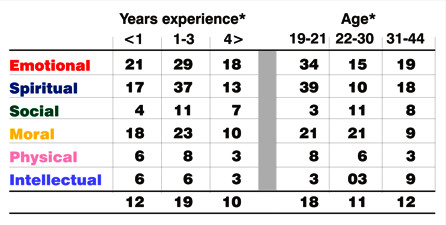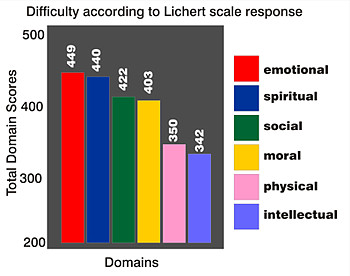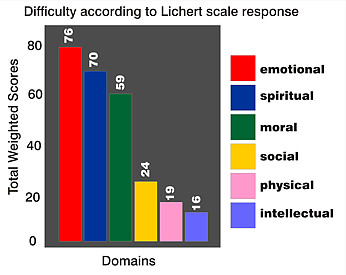 and reach thousands of daily visitors
and reach thousands of daily visitorsAn exploratory study was conducted on forty-five Child and Youth Care students to determine potential degree of difficulty with questions often asked by children and youth. Thirty questions were organized into six domains (emotional, spiritual, moral, social, physical and intellectual) and subjects identified both degree of question difficulty and individually difficult questions. Results suggest children's questions in the emotional and spiritual domains to be the most difficult with subject age and number of years work experience, as key factors. Implications for Child and Youth Care training programs are described.
“Where do babies come from?” “Why are there wars?” “How old is God?” are poignant questions which may be asked of workers by children. Knowing how to respond to these and other questions, regardless of the situation and age of the child, may at times be a difficult task. It is clearly not possible for workers to predict the scope and nature of child initiated questions. Therefore, rather than providing beginning child care workers with a comprehensive list of possible questions and accompanying responses, identification of certain types or clusters of perceived difficult questions may be useful.
Communication skills training is recognized as a core component of any Child and Youth Care training program (VanderVen, Mattingly and Morris, 1982). However, texts used either focus or generic counselling approaches (Adler and Towne, 1984; Coombs and Avila, 1985; Egan, 1986) or intervention techniques based on one particular framework (Cochrane and Myers, 1980).
Rather than counselling approaches to use in a variety of situations, attention needs also to be given to the types of client initiated questions most often asked of Child and Youth Care professionals. Whereas at times it may be important for the children to work through their own concerns, it is equally important for workers to be aware and respond directly to problematic and possibly embarrassing questions.
In order to examine this area, questions considered “difficult” were generated by students and practitioners working with children and youth. Careful examination of questions received, indicated the following six clusters, termed “domains.”
Question domains (Q.D.)
For each of the following six areas, operational definitions are
presented, including several question examples used in the
Identification of Difficult Questions (I.D.Q) questionnaire. Although
questions may appear to contain elements of other domains, in this
survey they were represented by one key domain.
Emotional domain: Questions within the emotional domain contain personal feelings and issues of concern. These types of questions may be accompanied by states such as depression, guilt, fear or anxiety. The following are examples: “Why don’t teachers talk to kids the way they talk to adults”? “Why is my dad an alcoholic”? “Why doesn’t my family love me?”
Spiritual domain: Questions of a spiritual nature in this questionnaire are inquiries about God, religion and/or faith. The concept of spirituality proposed here is of a religious nature; that is, spirituality is a belief in a supreme being or deity who is concerned about the welfare of the individual. Question examples include: “What happens to me when I die?” “Is God dead?” “How do you prove the existence of God?”
Moral domain: Moral questions are those that involve a value, ethical and/or philosophical orientation. An example from this domain is “Why does cancer take the best people in life away from those who need them the most?” This domain also includes questions about how a person functions and individual standards which govern behavior (e.g., “What is safe sex?”)
Social domain: Inherent in questions of a social nature are issues about relationships, society and the child's position within society. These concerns may often be related to relationships and interactional issues with peers and family. Representative questions within this domain on I.D.Q. questionnaire are “When will I find a real friend?” “Why do my friends always tell me what to do?” “What can I do to make others love me?”
Physical domain: Questions within the physical domain may be one of two types: the physical self and interactions with physical and inanimate objects within the child's world. Questions focusing on personal physique may be in reference to appearance and body image – “When will I look pretty?” “Why do I have diabetes?” or the child's physical and personal world – “Why can’t I draw well when I try as hard as I can?”)
Intellectual domain: Questions in this domain require knowledge-based answers, reflecting a wide range of subject areas. Whereas some child initiated questions may be in relation to the physical world – “How can it be night time here and day time in another country?”, others refer to the immediate world of the child or adolescent – “How does time work?”, “How do I make good money at such a young age besides a paper route?”.
The purpose of this study was to explore each question domain identified in order to assist beginning practitioners in becoming aware of the range of possible child and youth initiated questions and of the possible difficulties some students may have in responding appropriately.
Method
Questions were gathered over a three month period from employees at a
child and adolescent psychiatric treatment facility, Child and Youth Care students, educators and professional colleagues. Each person wrote
questions asked of them by children and/or youth that they found
difficult to answer. In addition, selected practitioners were asked to
note questions they considered children and youth were hesitant to ask.
Content analyses of the 115 questions revealed six domains and thirty questions considered representative were selected (five from each domain). Questions were then randomly compiled in a questionnaire format and administered to forty-five second year students in the School of Child Care, University of Victoria. Subjects were asked to rate each question using a five point Lichert scale, with 0 being the least difficult to 4 indicating the greatest difficulty in responding. Subjects were also asked to note the three most difficult questions overall.
Results and discussion
Subjects comprised thirty-nine (87%) female and six (13%) male students
ranging in age from nineteen to forty-five years (x=26.7, sd=8.1).
Professional work experience ranged from less than one year (N=12), to
one to three years (N=19) and ten with four or more years experience
(x=2.3., sd=1.4).
The following table outlines sub-categories by subject age and years experience with weighted totals in each domain.
Table 1
Weighted domain totals of respondents age and years experience

Reverse weighting and average indexing (Babbie, 1986) were used to determine domain difficulty by both age and years experience. Here, each of the three most difficult questions that respondents listed were given a weight (#1 chosen most difficult question received a score of 3, #2 most difficult=2 and #3 most difficult=l) and then combined according to domain. Scores for each domain were tabulated according to assigned question weights. In order to control for different sample sizes amongst respondents' age and years work experience (e.g., 19-21 years, 22-30 years, or, less than one year experience, 1-3 years experience), the weighted score of each domain was averaged through division of overall category “N”.
The following two main questions were addressed:
Figure 1

A difference in terms of total scores from all domains is shown. Whereas total possible domain scores could range to 900, results do show an overall trend for greater perceived difficulty of questions in the emotional and spiritual domains, rather than questions from the physical and intellectual domains.
Figure 2

When asked to record the three most difficult questions overall, respondents chose #26, #29 and #3, representing the emotional (#26: “Why doesn’t my family love me?”) and spiritual (#29: “How do you prove the existence of God?”, #3: “What happens to me when I die?”) domains respectively. That is, from the I.D.Q. students considered questions of an emotional (elements of personal feelings and concern) and spiritual nature (inquires about God, religion and faith) to be the most difficult types of child-initiated questions to answer. Results from overall difficult domain areas coincide with individually difficult questions in that the emotional, spiritual and moral domains were seen as potentially being the most difficult. Responses to questions of an intellectual (factual-based) nature are generally straight forward and do not often involve uncertainty or the need for competence in counselling skills. Emotional and spiritual questions, however, may require a more complex and sensitive response to a troubled young client. In light of these results, further research could be conducted to determine if students are imagining scenarios and/or situations that these questions illicit. Given that most of these students had only beginning communication and intervention skilled training, this may in some part explain their perceptions about these difficult question areas.
2. Did subjects' identified difficult question domains vary with age? Emotional and spiritual, and to a lesser degree, moral questions were selected as the most problematic, regardless of amount of work experience. However, respondents with less than one year and more than four years experience in child care work specifically, find emotional questions difficult, while students with one to three years experience, may find spiritual questions difficult. In all cases intellectual, social and physical questions were not considered highly difficult. Perhaps the reason workers with one to three years experience find spiritual questions more difficult is because of an interaction between age, stage of training and experience. Subsequent study would be needed to determine if subject sex is also a factor.
Implications
This study present six domains within which children and youth may ask
difficult questions of workers. Results suggest that some questions may
prove more difficult for workers in providing appropriate responses,
than others. On the basis of this exploratory examination it is
suggested that courses in applied child and adolescent development and
communication skills training within Child and Youth Care programs
consider the area of question domains and types of questions children
and youth may ask. Further research could explore the reasons why the
emotional and spiritual domains are perceived as most difficult and if
students (or practitioners) following additional years of study or
experience would respond differently to this measure. Perceived
difficulty, as separate from actual question difficulty, needs to be
measured, perhaps through the use of situational scenario with children
and youth.
Summary
Child and youth care practitioners identified a number of difficult
questions asked by children. Questions received formed the basis of a
questionnaire (I.D.Q) and results suggest emotional, spiritual and to a
lesser degree, moral questions, potentially difficult for beginning
Child and Youth Care workers regardless of age and years experience. It
is suggested that the understanding of question domains is necessary
when preparing workers to function in a range of settings and situations
with children and youth.
References
Adler, R.B. and Towne, N. (1984). Looking out/Looking in (4th ed.). New York. Holt, Rinehart & Winston.
Babbie, E. (1986). The practice of social research (4th ed.). Belmont, California. Wadsworth.
Coombs, A.W. and Avila, D.L. (1985). Helping relationships (3rd ed.). Newton, Massachusetts. Allyn & Bacon.
Cochrane, C.T. and Myers, D.V. (1980). Children in crisis. California. Sage.
Egan, G. (1986). The skilled helper: A model for systematic helping and interpersonal relating (3rd ed.). Monterey, California. Brooks/Cole.
Vanderven, K., Mattingly, M. and Morris, G. (1982). Principle and guidelines for child care personnel preparation programs. Child Care Quarterly, 11. pp. 242-249.
This feature: Ruttan, D.A. and Denholm, C.J. (1989). Identification of difficult question domains for Child and Youth Care students. Journal of Child and Youth Care, 4, 2. pp. 35-42.